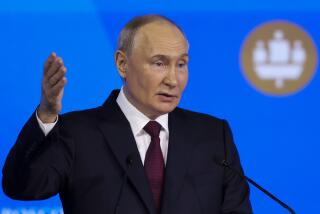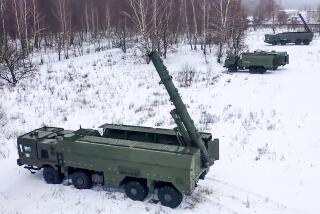CRISIS IN THE KREMLIN : Bush, Soviet Official Offer Reassurances on A-Arms : Weapons: Both try to defuse worries that the arms could have fallen into the wrong hands during the crisis.
MOSCOW — Although their comments were brief, lacked detail and were chiefly aimed to reassure, both President Bush and Soviet Foreign Minister Alexander A. Bessmertnykh on Wednesday sought to address one of the most worrisome issues during the Soviet coup--over the preceding three days, who controlled this nation’s nuclear arms?
The Strategic Rocket Forces and their intercontinental ballistic missiles (ICBMs) “were under control of the competent bodies, and the structure of military command was not changed or modified in any way,” Bessmertnykh asserted, adding, “Fears that these forces could get out of control are groundless.”
In reply to a question at his morning news conference about the Soviets’ nuclear security, Bush replied: “We see no reason to be concerned about that. Our people are taking a hard look at that all the time.”
So, too, are the Soviets. As recently as last fall, Kremlin officials and the Soviet military brass ridiculed the possibility that they might confront a nuclear nightmare straight out of a Tom Clancy high-tech thriller--the Kremlin’s loss of control over some deadly piece of its atomic arsenal, seized, perhaps, by a splintering republic or a terrorist group.
Although Soviet officials had insisted that the dire scenario could never happen, they have been taking the threat seriously and quietly pursuing countermeasures. Those steps acquired new significance after the weekend coup against and the restoration Wednesday of President Mikhail S. Gorbachev.
“The leadership of the Soviet armed forces . . . has a stake in preventing nuclear weapons from falling into unauthorized hands, with the subsequent blackmail that it would allow,” Defense Ministry spokesman Lt. Col. Vladimir P. Lyaschenko said in an interview, conducted before the current Soviet crisis began.
Last November, Marshal Dmitri T. Yazov--the Soviet defense minister who was a key figure in the weekend Gorbachev coup and whose own fate was unclear Wednesday--issued an extraordinary declaration regarding the Soviet Union and its arms.
His declaration made it clear that, despite demands by the republics for greater self-government and their own armies, Soviet nuclear stocks--which some Western estimates put at 30,000 warheads--”have been, are and will remain in the hands of the unified armed forces of the U.S.S.R.”
And even as Gorbachev was negotiating a Union Treaty with the republics about their new roles and relationships with the central government--an agreement that in all likelihood was the last straw for his right-wing enemies--the national government continued to reserve for itself the powers of “declaring war and concluding peace,” as well as the functions of “ensuring defense and exercising guidance over the armed forces.”
After Yazov’s proclamation, the Defense Ministry launched a “special program” to implement it. It took into account ethnic turmoil and pro-independence campaigns in some Soviet regions, such as the Caucasus and Baltic republics.
These measures were outlined in interviews with Soviet military officials, conducted before the coup. They apparently were their first such discussions on the issue and disclosed that the Soviets have taken the following steps:
* Elite units are now designated to protect depots of tactical nuclear arms such as mines and artillery shells. Some of these devices reportedly are as small as eight inches and are light enough to be carried by one person. “Special security procedures have been devised for emergencies, right down to the use of assault helicopters and paratroopers and airborne assault brigades,” Lyaschenko said. “These units and equipment would be employed to seal off a locality where an attack occurred, and then crush the attackers.”
* Storage procedures for tactical nuclear arms were “tightened further,” and as much as was possible, the weapons were stockpiled in “low-profile” installations, Lyaschenko said. Yazov also authorized soldiers to open fire if their installations were to come under attack, an occurrence that had become increasingly common in the Soviet Caucasus but that had dropped off sharply since.
* Special units, often acting in conditions of secrecy, are used to dismantle, transport and reassemble nuclear weapons--for example, warheads repatriated by Soviet troops leaving the territory of former Warsaw Pact allies in Eastern Europe.
The Soviet command was reassessing technological measures to safeguard nuclear weapons, such as electronic “locks” to prevent the arming of the devices by unauthorized personnel.
Although the Soviet leadership has sent conflicting signals, perhaps intentionally, on whether nuclear arms have been withdrawn from the country’s ethnic hot spots, many defense attaches in Moscow and Western military specialists conclude that the transfers have occurred.
“Pragmatic realism at the center resulted in the discreet removal of tactical nuclear weapons from storage depots in the restive republics, a process reportedly begun in 1990 and more or less completed during the Gulf War period,” Bruce G. Blair of the Brookings Institution testified before the House Armed Services Committee last month.
“I doubt whether a single nuclear weapon can (now) be found in the Baltics, or in any of the volatile peripheral regions of the union,” he added. “Such weapons have probably been consolidated inside the Russian republic in depots that have always held the lion’s share of the (Soviet) nuclear arsenal.”
Although Soviet officials refused to discuss where their country’s nuclear arms are based, informed U.S. sources say the bulk of the 22 Soviet ICBM fields lie in a great arc that sweeps across Russia from Europe along the Trans-Siberian Railway to the Far East, with the only exceptions being fields in the Ukraine and Kazakhstan.
A few bomber bases are also situated outside Russia--in Kazakhstan, Byelorussia, the Ukraine and Estonia, sources said. Ports for nuclear-capable warships are almost exclusively in Russia (and Sevastopol, home to the Black Sea fleet, is in a Russified area of the Ukraine’s Crimean peninsula).
But virtually every republic, the Baltic trio of Lithuania, Latvia and Estonia excepted, is believed to contain at least some nuclear facilities, such as weapons plants, bomber bases and naval bases. And tactical nuclear weapons are so small and mobile that Western sources say it is impossible to pinpoint their location with anything near 100% accuracy.
Nevertheless, despite such grounds for uncertainty, the steps taken by the Soviet military and political leadership to safeguard the country’s strategic and tactical nuclear arms were greeted with something akin to relief in Washington.
“We are a lot less worried about this issue than we were a year ago,” a State Department spokesman said. The spokesman, who asked not to be identified further and was interviewed before the Gorbachev coup, added: “The chance that nuclear weapons could be used by any but the highest central authorities in the Soviet Union is low, given the security and control devices associated with them.”
Still, even in interviews conducted before the current Kremlin crisis, Western analysts expressed grave concern about the Soviets’ nuclear security in the event of internal instability.
As Lt. Gen. Harry Soyster, director of the Defense Intelligence Agency, observed, a long stretch of civil disorders could undermine “the political control and reliability of the Soviet military and the security of nuclear weapons.”
More to Read
Sign up for Essential California
The most important California stories and recommendations in your inbox every morning.
You may occasionally receive promotional content from the Los Angeles Times.









